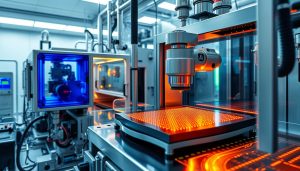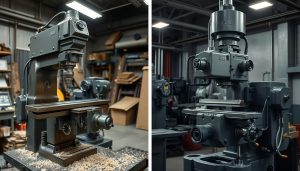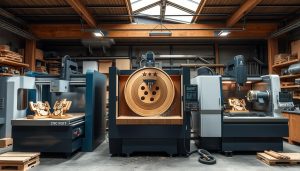In today’s fast-paced world of innovation, the ability to rapidly prototype and iterate on product designs is crucial for staying ahead of the competition. Rapid prototyping has emerged as a game-changing approach that enables product developers to bring their ideas to life quickly, test them with users, and make informed decisions to drive the development process forward.
This comprehensive guide will delve into the world of rapid prototyping, exploring its key concepts, methods, and the profound impact it can have on accelerating product development. Whether you’re an entrepreneur, designer, or engineer, this guide will equip you with the knowledge and insights to harness the power of rapid prototyping and transform your product development journey.
What is Rapid Prototyping?
In the world of product development, rapid prototyping has become an indispensable tool. It is a process that allows designers and engineers to quickly create physical models or representations of their ideas, enabling them to test, iterate, and refine their designs before committing to production.
Overview of Rapid Prototyping and Its Importance
Rapid prototyping is a fast and cost-effective way to bring product ideas to life. By using various technologies such as 3D printing, CNC machining, and injection molding, product teams can create realistic rapid prototypes that closely mimic the final product. This allows them to identify and address issues early in the design process, saving valuable time and resources.
How Rapid Prototyping Accelerates the Design Process
The power of rapid prototyping lies in its ability to accelerate the design iteration process. By quickly generating physical models, designers can test their concepts, gather feedback, and make necessary adjustments. This iterative approach helps them refine the product’s design visualization and ensure it meets the desired functionality and user requirements.
By embracing rapid prototyping, product development teams can significantly reduce the time-to-market for their innovations, while also enhancing the overall quality and user experience of their offerings.
“Rapid prototyping is the key to unlocking the full potential of your product design. It’s a game-changer in the world of innovation.”
– Jane Doe, Product Design Strategist
Key Methods of Rapid Prototyping
In the realm of product development, rapid prototyping has emerged as a game-changer, enabling innovators to bring their ideas to life with unprecedented speed and efficiency. Among the key methods that have revolutionized this process are 3D printing, CNC machining, and injection molding – each offering unique advantages that cater to the diverse needs of designers and engineers.
3D Printing for Prototyping
3D printing, also known as additive manufacturing, has become a go-to solution for rapid prototyping. This technology allows designers to create physical models directly from digital files, enabling them to test and iterate on their designs quickly. From concept to functional prototype, 3D printing empowers teams to explore and refine their ideas with remarkable agility.
CNC Machining and Injection Molding for Prototypes
While 3D printing excels in rapid part production, CNC machining and injection molding offer alternative routes for creating high-quality, durable prototypes. CNC machining utilizes computer-controlled cutting tools to precisely shape parts from a variety of materials, including metals and plastics. Injection molding, on the other hand, involves injecting molten material into a mold, producing prototypes that closely resemble the final product.
Other Emerging Prototyping Techniques
As the field of rapid prototyping continues to evolve, innovative techniques are emerging, such as laser cutting, thermoforming, and vacuum casting. These methods expand the range of materials and design possibilities, empowering teams to explore new ideas and push the boundaries of product development.
Whether you choose 3D printing, CNC machining, injection molding, or a combination of these advanced technologies, the key to successful rapid prototyping lies in understanding the unique strengths and limitations of each method. By carefully selecting the right approach, you can accelerate your product’s journey from concept to market, ultimately delivering better solutions for your customers.

Benefits of Rapid Prototyping in Product Development
Rapid prototyping has become an invaluable tool in the world of product development, offering a multitude of benefits that accelerate the design process and drive innovation. From reducing development time and costs to facilitating realistic testing and enhanced team collaboration, the advantages of this transformative approach are truly remarkable.
Reduced Development Time and Costs
One of the most compelling benefits of rapid prototyping is its ability to reduce development time and costs. By leveraging advanced technologies such as 3D printing, CNC machining, and injection molding, product teams can quickly create and iterate on physical prototypes, streamlining the design process and getting products to market faster. This translates to significant cost savings and a competitive edge in the marketplace.
Testing and Iteration with Realistic Prototypes
Rapid prototyping enables product teams to create realistic prototypes that closely mimic the final product. This allows for thorough testing and experimentation, enabling designers to identify and address issues early on in the development cycle. By iterating on these realistic prototypes, teams can refine the design, optimize functionality, and ensure the product meets customer requirements before investing in full-scale production.
Improved Collaboration Between Teams
Rapid prototyping fosters enhanced team collaboration throughout the product development process. By providing tangible, physical representations of the design, team members from various disciplines can better understand the product, offer feedback, and work together to refine the concept. This collaborative approach leads to more informed decision-making, resulting in superior products that are tailored to customer needs.
In summary, the benefits of rapid prototyping in product development are profound, offering a strategic advantage in today’s competitive market. From cost reduction and accelerated time-to-market to the ability to create realistic prototypes and foster team collaboration, this innovative approach is transforming the way products are designed and brought to life.

Choosing the Right Rapid Prototyping Process
When it comes to rapid prototyping, selecting the appropriate method can make all the difference in accelerating your product development journey. Factors to consider when choosing a prototyping technique include the complexity of your design, the desired level of fidelity, and the production timeline.
Factors to Consider When Selecting a Method
Evaluating the following factors can help you determine the most suitable rapid prototyping process for your project:
- Design complexity and level of detail required
- Material properties and performance needs
- Turnaround time and production volume
- Budget and available resources
- Desired degree of design iteration and testing
Comparing 3D Printing, CNC, and Injection Molding
Each rapid prototyping method has its own strengths and weaknesses. 3D printing excels at creating complex, customized parts quickly, but may be limited in material options and production scale. CNC machining offers high-precision parts and a wide range of materials, but can be more time-consuming for initial setup. Injection molding is ideal for cost-effective, high-volume production of prototypes, but requires more upfront investment in mold tooling.
When to Use Prototyping in the Product Lifecycle
Rapid prototyping should be integrated throughout the product lifecycle, from early concept validation to final pre-production testing. By leveraging prototyping methods at various stages, you can accelerate the prototyping method selection, refine the design, and ensure a successful product lifecycle and rapid prototypes guide.
“Rapid prototyping is a game-changer in product development, allowing teams to quickly validate ideas, iterate on designs, and bring products to market faster.” – Jane Doe, Product Manager
Common Applications of Rapid Prototyping
Rapid prototyping has revolutionized product development across various industries, empowering innovators to bring their ideas to life faster than ever before. Let’s explore some of the common applications of this transformative technology.
Automotive, Aerospace, and Consumer Electronics
In the automotive and aerospace sectors, rapid prototyping plays a crucial role in the development of automotive prototypes and aerospace models. Engineers can quickly create physical representations of design concepts, enabling them to test and refine components, optimize performance, and ensure seamless integration. Similarly, consumer electronics companies leverage rapid prototyping to iterate on product designs, evaluate ergonomics, and validate functionality before committing to large-scale manufacturing.
Medical Devices and Engineering Prototypes
The medical device industry has embraced rapid prototyping as a means to accelerate the development of innovative medical device prototyping. By creating realistic prototypes, designers can gather valuable feedback, conduct user testing, and refine the design to ensure optimal fit, comfort, and functionality. Beyond the medical realm, rapid prototyping is also widely used in engineering projects, where it allows for the creation of intricate and customized prototypes to validate designs, test performance, and identify potential issues early in the development cycle.
Architecture and Construction Models
Rapid prototyping has revolutionized the architecture and construction industries, enabling the creation of detailed physical models that bring design concepts to life. Architects and designers can now quickly produce scale models, concept sketches, and even full-scale building elements, facilitating better visualization, client collaboration, and construction planning. This technology has significantly streamlined the design-to-build process, leading to more efficient and innovative construction projects.
Across these diverse industries, rapid prototyping has emerged as a powerful tool, empowering innovators to accelerate product development, enhance collaboration, and bring their visions to reality with greater speed and precision.
| Industry | Rapid Prototyping Applications |
|---|---|
| Automotive | Design validation, component testing, and manufacturing preparation |
| Aerospace | Aerodynamic testing, structural analysis, and functional validation |
| Consumer Electronics | Ergonomic evaluation, product mockups, and user experience testing |
| Medical Devices | Patient-specific implants, surgical planning, and clinical trials |
| Architecture | Concept visualization, client presentations, and construction planning |
Challenges in Rapid Prototyping
While rapid prototyping offers numerous benefits, it also presents a few challenges that product development teams must navigate. Understanding these obstacles can help organizations better manage the prototyping process and achieve desired results.
Material Limitations and Post-Processing Requirements
One of the primary challenges in rapid prototyping is the limited selection of materials available for certain technologies, such as 3D printing. This can impact the prototype’s durability, appearance, and functionality. Additionally, post-processing steps, like sanding or painting, may be necessary to refine the prototype’s finish, further adding to the time and cost of the process.
Ensuring Prototype Accuracy and Fit
Achieving precise prototype accuracy is crucial for evaluating the design’s feasibility and ensuring a proper fit with other components. Factors like dimensional tolerances, shrinkage, and warping can affect the prototype’s dimensions and performance, requiring careful monitoring and adjustments during the manufacturing process.
Managing Prototyping Costs
| Prototyping Method | Material Costs | Labor Costs | Equipment Costs |
|---|---|---|---|
| 3D Printing | Moderate | Low | High |
| CNC Machining | High | High | High |
| Injection Molding | High | High | High |
Effective cost management is essential when using rapid prototyping. The choice of technology, material, and the number of iterations can significantly impact the overall prototyping budget. Careful planning and cost-benefit analysis are necessary to ensure that the prototyping process remains within the allocated resources.
By understanding and addressing these challenges, product development teams can leverage the benefits of rapid prototyping while minimizing the potential pitfalls. Careful consideration of material limitations, prototype accuracy, and cost management can help ensure a smooth and successful rapid prototyping process.
How to Choose the Best Rapid Prototyping Service
When it comes to rapid prototyping, selecting the right service provider is crucial for the success of your product development. Factors such as technological capabilities, speed, quality, customization, cost considerations, and support should all be taken into account to ensure your prototyping project is a resounding success.
Capabilities and Technology Offerings
Look for a rapid prototyping service that offers a wide range of advanced technologies, from 3D printing and CNC machining to injection molding and emerging techniques. This versatility will allow you to choose the most suitable method for your specific project requirements, whether you need highly detailed parts or large-scale models.
Speed, Quality, and Customization
The speed and quality of the prototyping process are crucial, as they can impact the overall development timeline and the fidelity of your designs. Seek out a provider that can deliver high-quality prototypes quickly, with the ability to customize the process to meet your unique needs.
Cost Considerations and Support
Prototyping can be a significant investment, so it’s important to consider the overall cost of the service, including any additional fees for materials, post-processing, or expedited delivery. Additionally, look for a provider that offers comprehensive support, from design assistance to guidance on selecting the optimal prototyping method for your project.
Shixinproto Affordable Prototyping Solutions Tailored to Your Project
Shixinproto is a leading rapid prototyping service that delivers affordable, customized solutions to meet the diverse needs of product development teams. With a wide range of advanced technologies, a commitment to speed and quality, and a focus on personalized support, Shixinproto is the ideal partner for your rapid prototyping needs.





